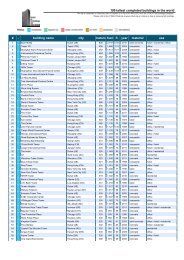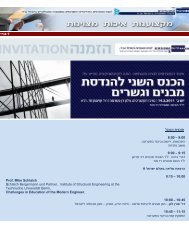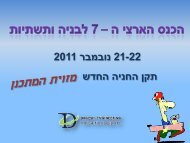צמנט רגיל צמנט : מסמך זה הוא הצעה בלבד מכון התקנים הישראלי
צמנט רגיל צמנט : מסמך זה הוא הצעה בלבד מכון התקנים הישראלי
צמנט רגיל צמנט : מסמך זה הוא הצעה בלבד מכון התקנים הישראלי
You also want an ePaper? Increase the reach of your titles
YUMPU automatically turns print PDFs into web optimized ePapers that Google loves.
ועדה 10601EN 197-1:2011 (E)dicalcium silicate and monocalcium aluminate. It also contains, besides small amounts of free calcium oxide andcalcium sulfate, larger proportions of pozzolanically reacting oxides, especially silicon dioxide. Consequently, in a finelyground state burnt shale shows pronounced hydraulic properties like Portland cement and in addition pozzolanicproperties.Adequately ground burnt shale shall have a compressive strength of at least 25,0 MPa at 28 days when tested inaccordance with EN 196-1. The test mortar shall be prepared with finely ground burnt shale only instead of cement. Themortar specimens shall be demoulded 48 h after preparation and cured in a moist atmosphere of relative humidity of atleast 90 % until tested.The expansion (soundness) of burnt shale shall not exceed 10 mm when tested in accordance with EN 196-3 using amixture of 30 % by mass of ground burnt shale and 70 % by mass of a CEM I cement conforming to EN 197-1.NOTE If the sulfate (SO 3) content of the burnt shale exceeds the permissible upper limit for the sulfate content of the cementthen this has to be taken into account for the manufacture of the cement by appropriately reducing the calcium sulfate-containingconstituents.5.2.6 Limestone (L, LL)Limestone shall meet the following requirements:a) The calcium carbonate (CaCO 3 ) content calculated from the calcium oxide content shall be at least 75 % by mass.b) The clay content, determined by the methylene blue test in accordance with EN 933-9, shall not exceed1,20 g/100 g. For this test the limestone shall be ground to a fineness of approximately 5 000 cm 2 /g determined asspecific surface in accordance with EN 196-6.c) The total organic carbon (TOC) content, when tested in accordance with EN 13639, shall conform to one of thefollowing criteria:1) LL: shall not exceed 0,20 % by mass;2) L: shall not exceed 0,50 % by mass.5.2.7 Silica fume (D)Silica fume originates from the reduction of high purity quartz with coal in electric arc furnaces in the production ofsilicon and ferrosilicon alloys and consists of very fine spherical particles containing at least 85 % by mass ofamorphous silicon dioxide. The content of elemental silicon (Si) determined according to ISO 9286, shall not be greaterthan 0,4 % by mass.Silica fume shall meet the following requirements:a) The loss on ignition shall not exceed 4,0 % by mass determined in accordance with EN 196-2 but using an ignitiontime of 1 h.b) The specific surface (BET) of the untreated silica fume shall be at least 15,0 m 2 /g when tested in accordance withISO 9277.For intergrinding with clinker and calcium sulfate the silica fume may be in its original state or compacted or pelletised(with water) or equivalently processed.5.3 Minor additional constituentsMinor additional constituents are specially selected, inorganic natural mineral materials, inorganic mineral materialsderived from the clinker production process or constituents as specified in 5.2 unless they are included as mainconstituents in the cement.13
















